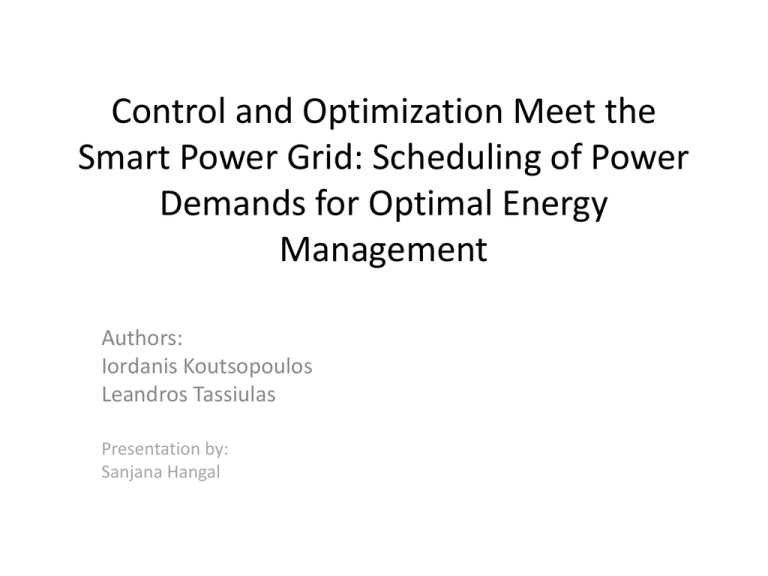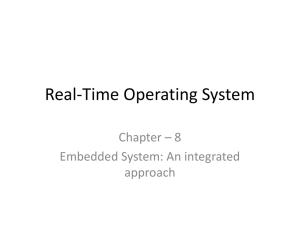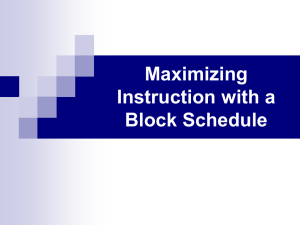Control and Optimization Meet the Smart Power Grid: Scheduling of
advertisement

Control and Optimization Meet the
Smart Power Grid: Scheduling of Power
Demands for Optimal Energy
Management
Authors:
Iordanis Koutsopoulos
Leandros Tassiulas
Presentation by:
Sanjana Hangal
Introduction
• Consider a scenario with real-time communication between
the operator and consumers.
• The grid operator controller receives requests for power
demands from consumers.
• Each request has different power requirement, duration, and
a deadline by which it is to be completed.
Introduction Cntd..
• The operational cost is a convex function of instantaneous
total power consumption
• This reflects the fact that each additional unit of power
needed to serve demands is more expensive as the demand
load increases
• Thus our aim is to reduce the operational cost of the
instantaneous power consumption for each task
Aim
• The supply profile shaping depends highly on demand profile,
the latter constitutes the primary foundation on which control
should be exercised by the operator
• The basic objective therefore is,
“to alleviate peak load by transferring non-emergency power
demands at off-peak-load time intervals”.
• Load management aids in smoothing the power demand
profile of the system across time by avoiding power overload
periods
Benefits
• From the system operator’s perspective,
effective demand load management reduces
the cost of operating the grid
• From the consumer’s perspective, it lowers
real time electricity prices
Approaches
• off-line version of the demand scheduling problem
– elastic demands (preemptive task scheduling) and
– inelastic demands (non-preemptive task scheduling)
• online dynamic scheduling problem
– Default Policy: No scheduling
– A Universal Lower Bound
– An Asymptotically Optimal Policy: Controlled Release
– Optimal Threshold Based Control Policies
THE MODEL
• Each power demand task n, n = 1, 2, . . . has,
– a time of generation an,
– a time duration sn time units, and
– an instantaneous power requirement pn (in Watts) when
the corresponding task is activated and consumes power
– Each task is characterized by delay tolerance in being
activated, this is the deadline dn , where dn≥ an by which it
needs to be completed
Cost Model
• At each time t, let P(t) denote the total instantaneous
consumed power in the system
• Then we denote instantaneous cost associated with power
consumption P(t) at time t as C(P(t))
• Convexity of C(・) reflects the fact that the differential cost of
power consumption for the electric utility operator increases
as the demand increases
• The cost may be a piecewise linear function of the form:
C(x) = max i=1,...,L {kix + bi}
with k1 ≤ . . . ≤ kL, accounting for L different classes of power
consumption, where each additional Watt consumed costs more
when at class ℓ than at class (ℓ − 1)
OFF-LINE DEMAND SCHEDULING PROBLEM
• For each task n = 1, . . . ,N, the attributes an, pn, sn and dn are
deterministic quantities which are known to the controller
before time t = 0
• Consider a finite time horizon T
• The offline demand scheduling can be done in 2 ways,
– Preemptive scheduling of tasks
– Non-preemptive scheduling of tasks
Preemptive scheduling of tasks
• The demands here are elastic in nature. Each task can be
interrupted and continued later such that it is active at
nonconsecutive time intervals
• The tasks have deadline dn fixed power requirement pn when
it is active.
• For each task n and time t we define the function xn(t),
xn(t) = 1, if job n is active at time t, t ∈ [0, T ], and
xn(t) = 0 otherwise.
• A scheduling policy is a collection of functions X = {x1(t), . . . ,
xN(t)}, defined on interval [0, T ]
Preemptive scheduling of tasks
Design
• The controller needs to find the scheduling policy that
minimizes the total cost in horizon [0, T ]
• The optimization problem faced by the controller is:
Subject to:
Continuous-valued problem
• Consider a bipartite graph U ∪ V.
• There exist |U| = N nodes on one side of the graph, one node
for each task.
• |V| nodes, where each node k corresponds to the
infinitesimal time interval [(k − 1) dt, k dt] of length dt.
• Let
denote the power load at time t
• The optimal cost problem is,
• The solution is load balancing across different locations
Non-preemptive scheduling of tasks
• The demands here are inelastic in nature. Once a task is
scheduled to start, the task should be served until it is
completion
• For each task, an = 0 and dn = D, this is common for all tasks.
• We also assume that power requirements are the same, i.e. pn
= p for all n
• Fix a positive integer m, the scheduling problem:
“Does there exist a schedule for the N tasks such that the
maximum instantaneous consumed power is mp?”
Bin Packing problem
• Bin Packing problem - ”objects of different volumes must be
packed into a finite number of bins or containers each of
volume V in a way that minimizes the number of bins used”.
• Partition the set of N items (tasks) into the smallest possible
number m of disjoint subsets (bins) U1, . . . ,Um such that the
sum of the sizes (sn)of items in each subset (bin) is D or less.
• Therefore the instantaneous power consumption is ‘mp’
• This is equivalent to the problem of finding a schedule of
power demand tasks that minimizes the maximum power
consumption over the time horizon T .
Online dynamic scheduling problem
•
•
•
•
Default Policy: No scheduling
A Universal Lower Bound
An Asymptotically Optimal Policy: Controlled Release
Optimal Threshold Based Control Policies
– Bi-modal control space
– Enhanced control space
Threshold based Control Policies
Bi-modal control space
• This approach has two modes in which the tasks are
scheduled, thus the control space is Ub[0, Dn]
• Each demand n is either scheduled immediately upon arrival,
or it is postponed to the end based on the threshold
• If the power consumption of task, P(t) > Pb then the task is
queued to be activated at the deadline otherwise the task is
activated immediately
• We call this policy, the Threshold Postponement (TP) policy.
Threshold based Control Policies
Enhanced control space
• In this approach each demand n is either scheduled
immediately upon arrival, or it is postponed to the end based
on the threshold
• Additionally we can schedule a demand after it is generated
and before its deadline is expired
• The control space is, Ue = {[an,Dn] for n = 1, 2, . . .}
• Whenever the deadline of the demand expires, the task is
activated
System State
Summary
• We have discussed the fundamental problem of smoothing
the power demand profile so as to minimize the grid
operational cost over some time horizon
• Various algorithms have been discussed to promote efficient
energy management
• Each of the algorithm is suitable for different scenarios
• The factors that affect load management are various the most
important being the cost to the operator and consumer
Thank you






